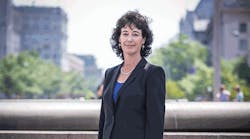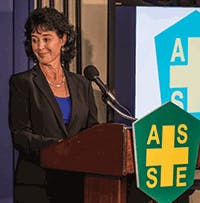We live in a true information age. People access information from web sites, books, a variety of mobile devices, even books on mobile devices! They watch webinars and films, listen to podcasts and radio programs, read newspapers and magazines and network in person. As someone who provides people with information for a living, I know it’s a delicate dance we have with our "customers," our readers.
How much information do they want online and is it the same type of information they’re interested in reading in a magazine or is it something different? Do they still read magazines? Are they more interested in attending "live" events, or would they prefer to watch a webinar at their desks or attend a virtual event?
So I could relate to what Patricia (Trish) Ennis, CSP, ARM, the outgoing president of the American Society of Safety Engineers (ASSE), had to say about the organization’s greatest successes and challenges in the past year. Ennis has been in safety management and consulting for 23 years, about the same amount of time I’ve been an editor at this magazine. Her employment includes work in the construction and insurance industries, and as director of workplace safety for the Denver Zoological Foundation. Her "day job" is a senior risk control consultant for Willis, North America Inc. in Denver, Colo.
Access to Information
When asked, "What are the greatest challenges/successes for ASSE in the past year?" Ennis replied, "Growing and enhancing the way our members can access their benefits: online, at events, through virtual education opportunities. Strengthening and adding practice specialties, adding members to those practice specialties and enhancing member access to them."
In order to achieve these goals, ASSE recently changed its governance structure, creating a smaller board of directors that is more strategic in nature. The hope is that the board effectively will recognize and capitalize on emerging opportunities that best serve ASSE’s mission.
Ennis added there is an ongoing conversation at the organizational level at ASSE regarding the "professionalization" of safety. "Is safety a profession or is it a career?" she asked. "Do we create barriers to entry?"
There probably is more diversity in terms of experience, education and qualifications among safety professionals and CSPs than ever before. These days, many entry-level safety professionals are newly graduated from universities, often with advanced degrees in safety-related fields. Many safety professionals in the field did not attend college for a degree in safety; they migrated into the field from other areas – production or human resources – and later achieved their certification as a safety professional. Still other EHS managers have no certifications or degrees.
One thing is certain for all of them, Ennis notes: "The days of looking at lagging indicators to position safety are over." That, and the increasing diversity of the workforce, make ASSE more relevant than ever, she believes.
Diversity and globalization – both in the practice of safety management and the workforce – has presented a number of challenges, "and challenges bring opportunities," she added.
"More and more jobs are being outsourced to Mumbai, India, other countries," she said, noting a new "vibrant" ASSE chapter in Nigeria that just held its second, successful professional development conference and the addition of new chapters in India to bring the total in that country to four. "Our members are being tasked with finding cost-effective ways to do more with less in terms of occupational safety and health and doing it with an increasingly diverse workforce."
Understand Organizational Goals
One way to do that, she insisted, it to align EHS goals with business goals. EHS professionals "need to understand the context in which the organization operates. Focus on that and go beyond compliance and look at the strategic goals of the organization."
Is your company’s focus on a global supply chain or on site-specific safety? The answer will dictate the direction of your safety process if you want to align with business interests, said Ennis.
Senior leadership at most organizations responds to numbers, so Ennis suggests using data analytics to support the case for safety. Years ago, slogans like "safety is the right thing to do" were very popular. It was difficult to quantify the value to the business of safety, so the idea was to make safety a "feel-good" aspect of doing business.
Ennis says that many safety professionals now are using data analytics to quantify the value to business by tracking leading indicators like training, risk management, identification and mitigation of hazards before injuries occur, worker compliance with company safety rules, safety surveys, observation programs and more. Safety professionals are creating standardized measurements for safety (i.e., metrics) and identifying trends to prevent injuries before they happen. Money saved is money earned, a concept business leaders understand.
Additional Opportunities
Ennis says that there are other areas where CSPs should focus their resources/time in the workplace. The first is being on top of a trend, in this case, the aging workforce.
How is the workplace impacted by aging workers in terms of productivity, workers’ compensation costs, ergonomics, etc.? And how does the "aging out" of workers with years of experience impact the work process and safety? These are things that safety professionals need to think about, according to Ennis.
Wellness is another aspect of the workplace that impacts safety, she adds. "I don’t think you can separate wellness from the workplace or safety," says Ennis. Healthy workers tend to suffer fewer injuries, miss fewer days of work and incur lower medical costs.
The educational program at Safety 2015, the annual professional development conference for the society that takes place this month, will offer many sessions and speakers that examine trends, provide practical advice, look ahead to the future, promote engagement and offer insight into world-class safety management.
Ennis also encouraged attendees to stay for the closing session, which features David Zweig, author of "Invisibles: The Power of Anonymous Work in an Age of Relentless Self-Promotion." In an age where gaining attention seems to be valued above all else, what kind of person chooses to work behind the scenes … and thrives there? According to Zweig, we too often measure our worth by the amount of praise we receive and, online, where we spend so much of our time today, by the number of "likes" and followers we have. But what if the supposed purpose of seeking all this attention is a myth?
Looking Back
Despite the challenges of launching structural changes to the organization and the push to provide information in ways that resonates with members, it’s obvious that Ennis has enjoyed her year as president of ASSE. In fact, she says, it is one of the things of which she is most proud in her career.
"My activities on the ASSE Board of Directors, planning educational events, mentoring people… Those are things I enjoy. Building things from scratch – creating a safety department where one didn’t exist – that’s been fun and rewarding for me in my career," she said. " I like working behind the scenes, seeing what’s behind the curtain, you could say."
"So I guess my advice would be to not put artificial limits on yourself because you never know what’s coming down the road or what skills you might need in your career," she said, adding with a laugh, "and you might need math, or public speaking."


